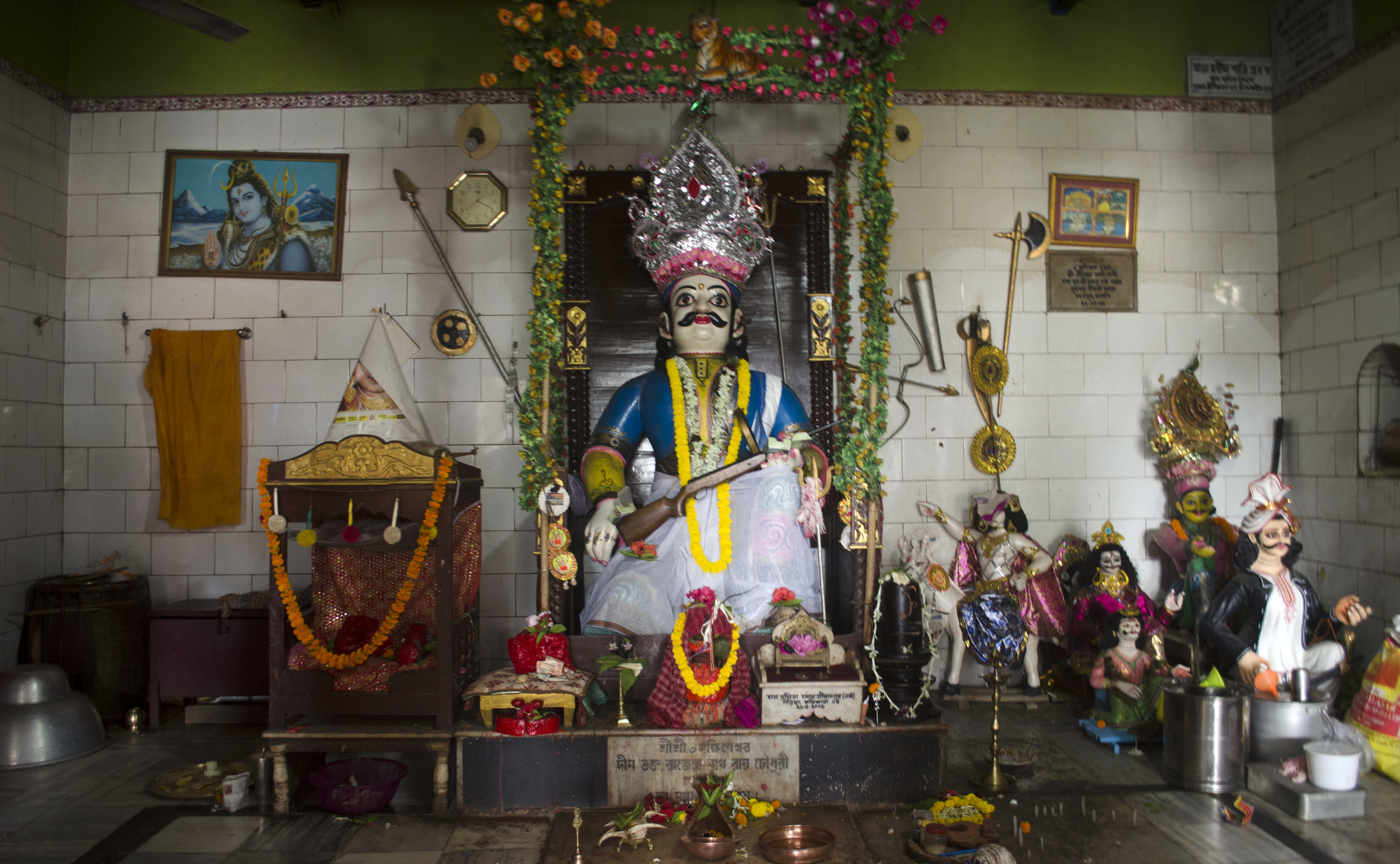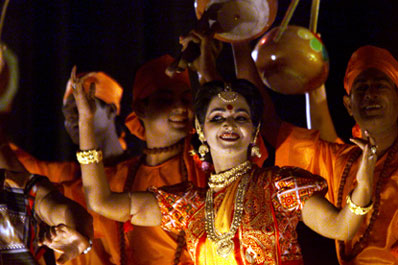|
Bonbibi
Banbibi, the lady of the forest, also Bandevi, Bandurga and Byaghradevi is a guardian spirit of the forests venerated by both the Hindu and the Muslim residents of the Sundarbans (spread across West Bengal state in eastern India and Bangladesh). She is called upon mostly by the honey-collectors and the woodcutters before entering the forest for protection against the attacks from the tigers. It is believed that the demon king, Dakkhin Rai (or Dakshin Rai; meaning Lord of the South), an arch-enemy of Banbibi actually appears in the disguise of a tiger and attacks human beings. The narratives of Banbibi The narratives of Banbibi are found in several texts named as the ''Banbibir Keramati'' (the magical deeds of Banbibi) or the ''Banbibir Jahuranama'' (glory to Banbibi). Amongst its earliest poets, Bayanuddin and Munshi Mohammad Khater are well known and their texts in the Bengali verse meter known as dwipodi-poyar (the two-footed line) are almost similar and are heavily influe ... [...More Info...] [...Related Items...] OR: [Wikipedia] [Google] [Baidu] |
Sundarbans
Sundarbans (pronounced ) is a mangrove area in the delta formed by the confluence of the Padma, Brahmaputra and Meghna Rivers in the Bay of Bengal. It spans the area from the Baleswar River in Bangladesh's division of Khulna to the Hooghly River in India's state of West Bengal. It comprises closed and open mangrove forests, land used for agricultural purpose, mudflats and barren land, and is intersected by multiple tidal streams and channels. Sundarbans is home to the world's largest area of mangrove forests. Four protected areas in the Sundarbans are enlisted as UNESCO World Heritage Sites, viz. Sundarbans West (Bangladesh), Sundarbans South (Bangladesh), Sundarbans East (Bangladesh) and Sundarbans National Park (India). Despite these protections, the Indian Sundarbans were considered endangered in a 2020 assessment under the IUCN Red List of Ecosystems framework. The Sundarbans mangrove forest covers an area of about , of which forests in Bangladesh's Khulna Division ex ... [...More Info...] [...Related Items...] OR: [Wikipedia] [Google] [Baidu] |
Gazi Pir
Gazi Pir (also called Ghazi Pir, Gaji Pir, Barkhan Gaji or Gaji Saheb) was a Bengali ( Muslim) Ghazi and '' pir'' (warrior saint) who lived in the 12th or 13th century during the spread of Islam in Bengal. He was known for his power over dangerous animals and controlling the natural elements. As the new local Muslim population of southern Bengal were settling in the dense forests of the Ganges delta, these were important qualities. His life is shown on the "Gazi Scroll", a scroll with 54 paintings from circa 1800, which is currently in the British Museum in London, England. In the villages of the Sundarbans jungles, Gazi Pir is worshiped alongside the Bonbibi and the Hindu Dakshin Rai, to ask for protection from tigers. According to the legends, Bonbibi taught that everyone is equal, no matter the caste or religion that one has, and that they should live in harmony with nature. Kolkata memorial Rani Rasmani, who created the Dakshineswar Kali Temple in Kolkata in 1847, saw ... [...More Info...] [...Related Items...] OR: [Wikipedia] [Google] [Baidu] |
Jungle Nama
''Jungle Nama'' is a graphic verse novel written by Indian author Amitav Ghosh and illustrated by Pakistani-American artist Salman Toor. It is a verse adaptation of the medieval Bengali tale about the Sundarbans Forest goddess, Bon Bibi. The book was first published on the 12th of February 2021 by Fourth Estate India and then in Great Britain on the 11th of November 2021 by John Murray Press. It is Ghosh’s first book in verse. The story explores themes of greed and ecological misadventure. (1,3) Ghosh states that the story is an allegory for human caused climate change. Background Setting The story is set in India's Sundarbans region. The Sundarbans are located across the western coast of Bangladesh and the south coast of India's Eastern state of West Bengal. The region is characterised by vast natural forests and deltas. At greater than ten-thousand square kilometre, the Sundarbans are the world’s largest mangrove forest. They are divided by three main rivers, the Ganga ... [...More Info...] [...Related Items...] OR: [Wikipedia] [Google] [Baidu] |
Dakkhin Rai
Dakshin Ray ( bn, দক্ষিণ রায়, "King of the South") is a revered deity in the Sundarbans in India and Bangladesh who rules over beasts and demons. He is regarded as the overall ruler of the Sundarbans. The God is worshipped by all those who enter the Sundarban forests of West Bengal, for subsistence, irrespective of their caste, creed or religion. Narrative In the Sealdah South lines, there is the station Dhapdhapi. A few miles away is a Dakshin Rai temple. The residents of the area worship this Tiger God. He once belonged to the area of the Sundarbans. His domain stretches from the south Namkhana Kakdwip the Bhagirathi- Hooghly River Ganga in the west to the Ghatal Bakla district in the east as well as Khulna Jessore District of Bangladesh. Every new moon (Amavasya), he is revered and appeased with animal sacrifices. Dakshin Rai also likes music and attracts musicians. The local tribes try their best to please the 'King of the South' by dancing and singi ... [...More Info...] [...Related Items...] OR: [Wikipedia] [Google] [Baidu] |
Amitav Ghosh
Amitav Ghosh (born 11 July 1956)Ghosh, Amitav , ''Encyclopædia Britannica'' is an Indian people, Indian writer. He won the 54th Jnanpith award in 2018, India's highest literary honor. Ghosh's ambitious novels use complex narrative strategies to probe the nature of national and personal identity, particularly of the people of India and South Asia. He has written historical fiction and also written non-fiction works discussing topics such as colonialism and climate change. Ghosh studied at The Doon School, Dehradun, and earned a doctorate in social anthropology at the University of Oxford. He worked at the The Indian Express, ''Indian Express'' newspaper in New Delhi and several academic institutions. His first novel The Circle of Reason (novel), ''The Circle of Reason'' was published in 1986, which he followed wi ... [...More Info...] [...Related Items...] OR: [Wikipedia] [Google] [Baidu] |
Hindustan
''Hindūstān'' ( , from '' Hindū'' and ''-stān''), also sometimes spelt as Hindōstān ( ''Indo-land''), along with its shortened form ''Hind'' (), is the Persian-language name for the Indian subcontinent that later became commonly used by its inhabitants in the Hindi–Urdu language. Hindustan was the Persian word for ''India'', but when introduced to the subjects under Persianate rule, the subsequent culture which resulted from these events gave it another specific meaning that of the cultural region between the river Sutlej (end of Northwestern India) and the city Varanasi (start of Eastern India). As the area where Ganga-Jamuni Tehzeeb and the Hindustani language traces its origins, it corresponds to the plains where the river Yamuna flows or the regions/states encompassing Haryana, Delhi, Harit Pradesh, and Awadh. Other toponyms for the subcontinent include ''Jambudvīpa'' and '' Bharata Khanda''. Since the Partition of India in 1947, although limitedly, ''Hindusta ... [...More Info...] [...Related Items...] OR: [Wikipedia] [Google] [Baidu] |
Bangladeshi Culture
The culture of Bangladesh is intertwined with the culture of the ''Bengal region'' of the Indian subcontinent. It has evolved over the centuries and encompasses the cultural diversity of several social groups of Bangladesh. The Bengal Renaissance of the 18th early 19th centuries, noted Bengali writers, saints, authors, scientists, researchers, thinkers, music composers, painters, film-makers have played a significant role in the development of Bengali culture. The Bengal Renaissance contained the seeds of a nascent political Indian nationalism which was the precursor in many ways to modern Indian artistic cultural expression. According to M. Nazrul Islam Tamij, a human rights activist and chairman of the National Human Rights Society (NHRS), human rights are the most important part of Bengali culture, and it plays an important role in the development of Bengali culture. The cultures of Bangladesh composite over the centuries have assimilated influences of Islam, Hinduism, ... [...More Info...] [...Related Items...] OR: [Wikipedia] [Google] [Baidu] |
Culture Of West Bengal
The culture of West Bengal is an Indian culture which has its roots in Bengali literature, music, fine arts, drama and cinema. Different geographic regions of West Bengal have subtle as well as more pronounced variations between each other, with Darjeeling Himalayan hill region and Duars showing particularly different socio-cultural aspects. West Bengal's capital Kolkata—as the former capital of India—was the birthplace of modern Indian literary and artistic thought, and is referred to as the "cultural r literarycapital of India". The presence of ''paras'', which are cluster of neighbourhoods that possess a strong sense of community, is characteristic of West Bengal. Typically, each ''para'' has its own community club and, on occasion, a playing field. Residents engage in '' addas'', or leisurely chats, that often take the form of freestyle intellectual conversation. However, with the growth of apartments, expansion of neighbourhoods and rapid urbanization, this culture i ... [...More Info...] [...Related Items...] OR: [Wikipedia] [Google] [Baidu] |
Climate Change And The Unthinkable
Climate is the long-term weather pattern in an area, typically averaged over 30 years. More rigorously, it is the mean and variability of meteorological variables over a time spanning from months to millions of years. Some of the meteorological variables that are commonly measured are temperature, humidity, atmospheric pressure, wind, and precipitation. In a broader sense, climate is the state of the components of the climate system, including the atmosphere, hydrosphere, cryosphere, lithosphere and biosphere and the interactions between them. The climate of a location is affected by its latitude/longitude, terrain, altitude, land use and nearby water bodies and their currents. Climates can be classified according to the average and typical variables, most commonly temperature and precipitation. The most widely used classification scheme was the Köppen climate classification. The Thornthwaite system, in use since 1948, incorporates evapotranspiration along with temperature an ... [...More Info...] [...Related Items...] OR: [Wikipedia] [Google] [Baidu] |
The Hungry Tide
''The Hungry Tide'' (2004) is the fourth novel by Indian-born author, Amitav Ghosh. Set in the Sundarbans, it follows an unlikely trio who travel up river together to find the rare Irrawaddy dolphin. It won the 2004 Hutch Crossword Book Award for Fiction. Synopsis Off the easternmost coast of India, in the Bay of Bengal, lies the immense labyrinth of tiny islands known as the Sundarbans. For settlers here, life is precarious: attacks by deadly tigers are common, and the threat of eviction and consequent social unrest is ever present. Without warning, at any time, tidal floods rise and surge over the land, leaving devastation in their wake. In this place of vengeful beauty, the lives of three people from different worlds collide. The main character, Piyali Roy, is a young marine biologist of Bengali-Indian descent but identifying as stubbornly American. Raised in Seattle, she studies at the Scripps Institute of Oceanography in La Jolla. She travels to the Sundarbans in s ... [...More Info...] [...Related Items...] OR: [Wikipedia] [Google] [Baidu] |
Sari
A sari (sometimes also saree or shari)The name of the garment in various regional languages include: * as, শাৰী, xārī, translit-std=ISO * bn, শাড়ি, śāṛi, translit-std=ISO * gu, સાડી, sāḍī, translit-std=ISO * hi, साड़ी, sāṛī, translit-std=ISO * kn, ಸೀರೆ, sīre, translit-std=ISO * knn, साडी, कापड, चीरे, sāḍī, kāpaḍ, cīrē, translit-std=ISO * ml, സാരി, sāri, translit-std=ISO * mr, साडी, sāḍī, translit-std=ISO * ne, सारी, sārī, translit-std=ISO * or, ଶାଢ଼ୀ, śāṛhī, translit-std=ISO * pa, ਸਾਰੀ, sārī, translit-std=ISO * ta, புடவை, puṭavai, translit-std=ISO * te, చీర, cīra, translit-std=ISO * ur, ساڑى, sāṛī, translit-std=ISO is a women's garment from the Indian subcontinent, that consists of an un-stitched stretch of woven fabric arranged over the body as a robe, with one end tied to the waist, while ... [...More Info...] [...Related Items...] OR: [Wikipedia] [Google] [Baidu] |
Pyjama
Pajamas ( US) or pyjamas (Commonwealth) (), sometimes colloquially shortened to PJs, jammies, jam-jams, or in South Asia night suits, are several related types of clothing worn as nightwear or while lounging or performing remote work from home. Pajamas are soft and loose garments derived from the Indian and Persian bottom-wear, the ''pyjamas''. They originated in the Indian subcontinent and were adopted in the Western world as nightwear. Etymology According to the ''Oxford English Dictionary'', the word pajama is a borrowing via Hindi from Persian. Its etymology is: Hindi pāy-jāma, pā-jāma and its etymon Persian pāy-jāma, pā-jāma, singular noun < Persian pāy, pā foot, leg + jāma clothing, garment (see jama n.1) + English -s , plural ending, after drawers. History The worldwide use of pajamas (the word and the clothing) outside the subcontinent is the result of adoption by British colonists |








.jpg)